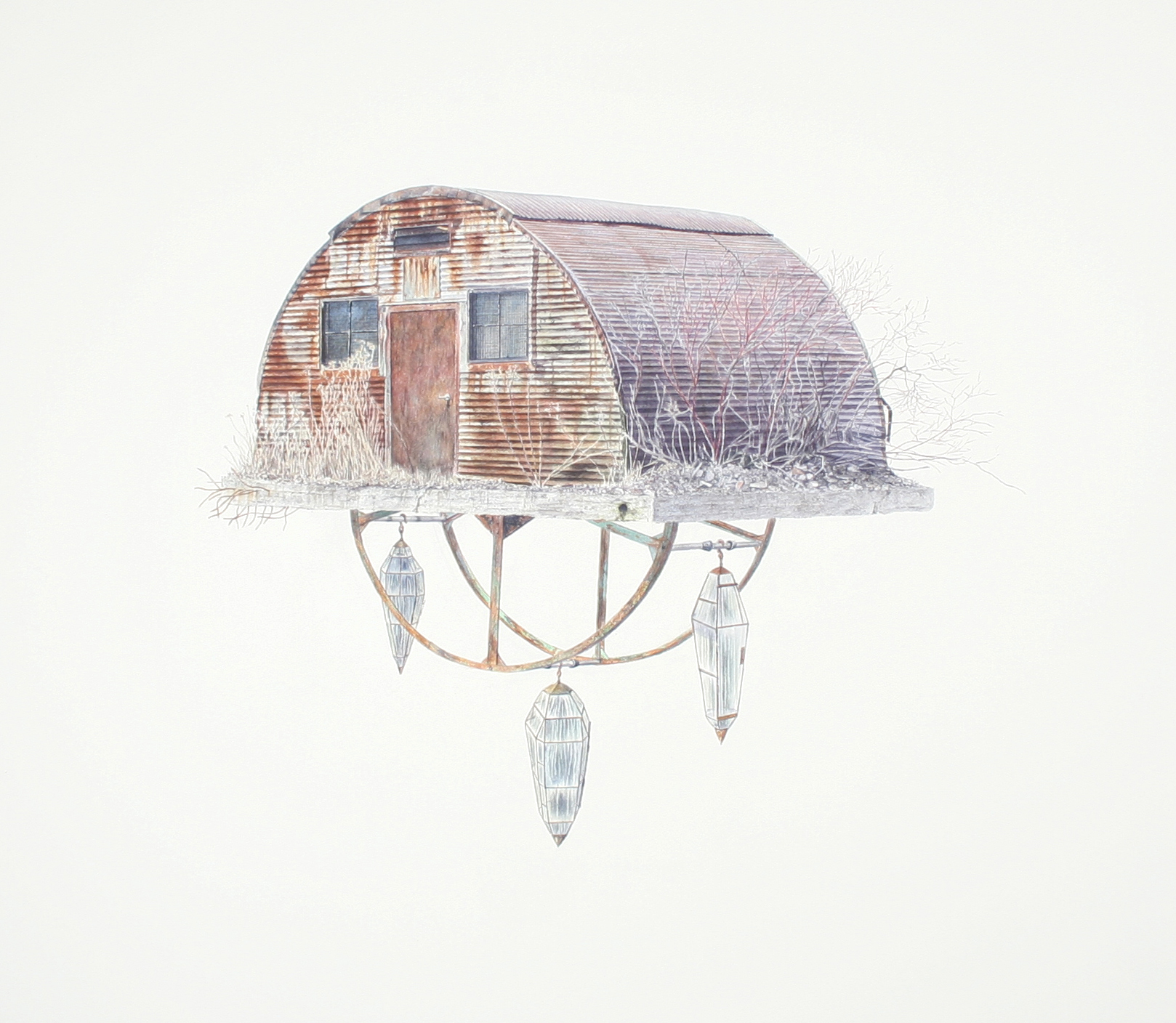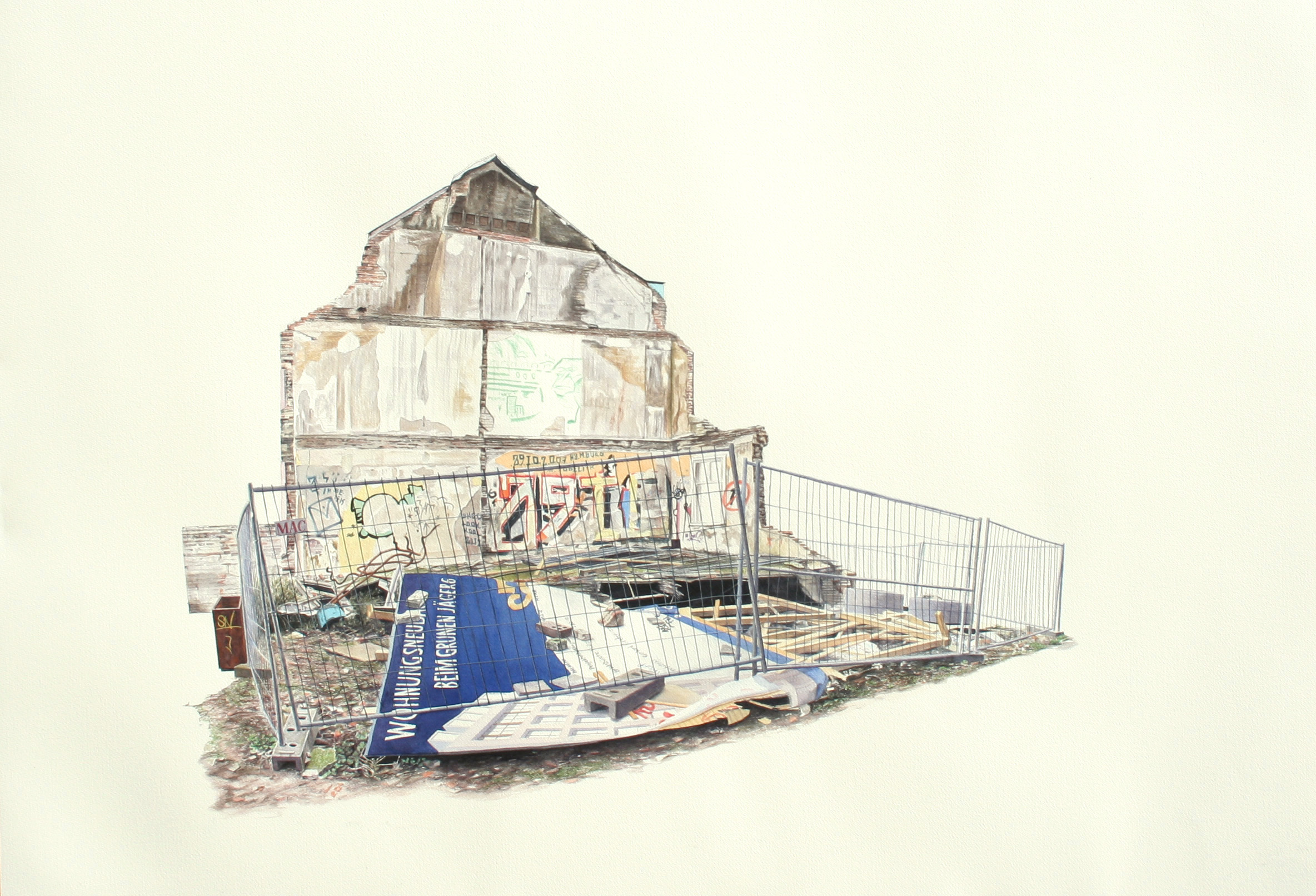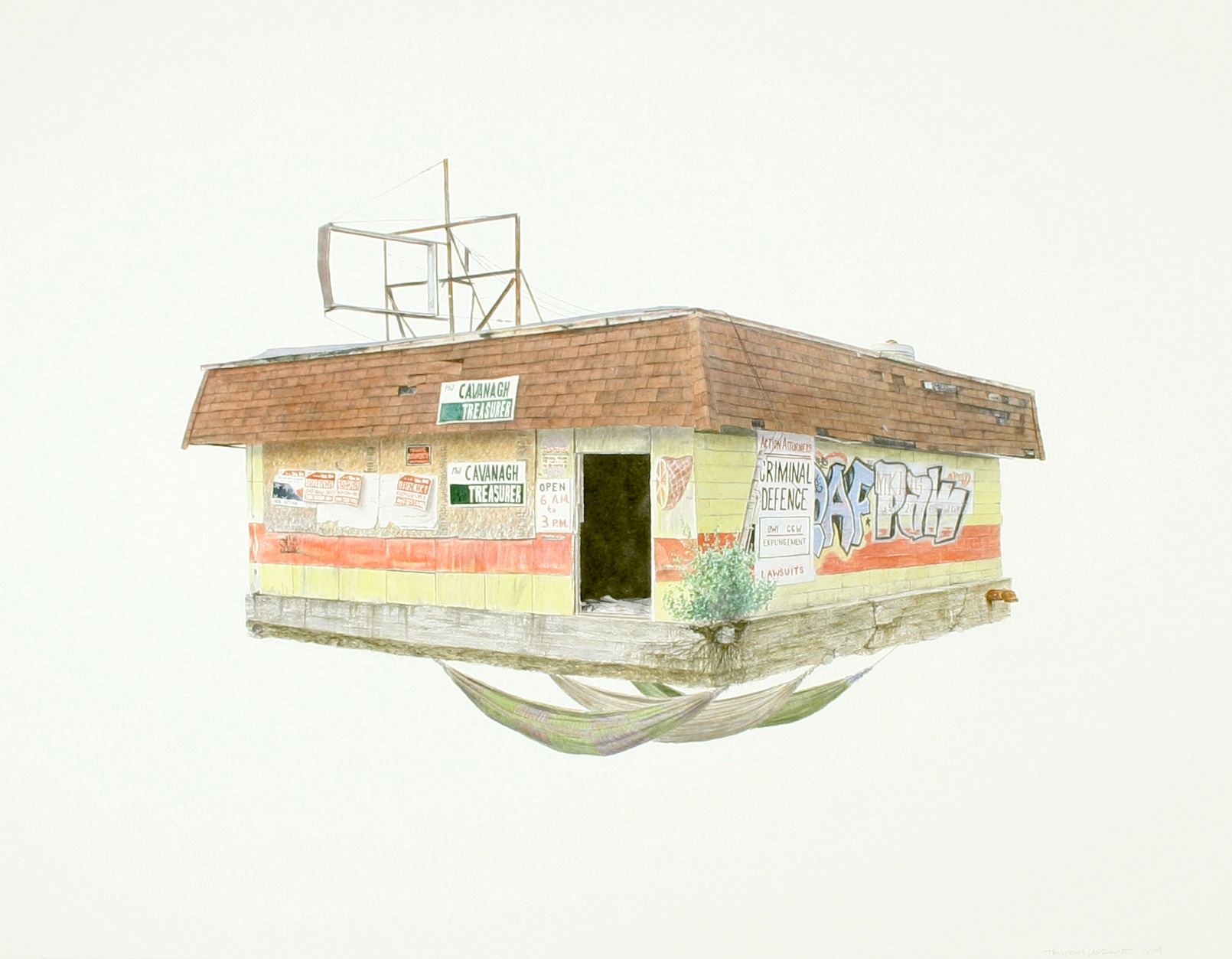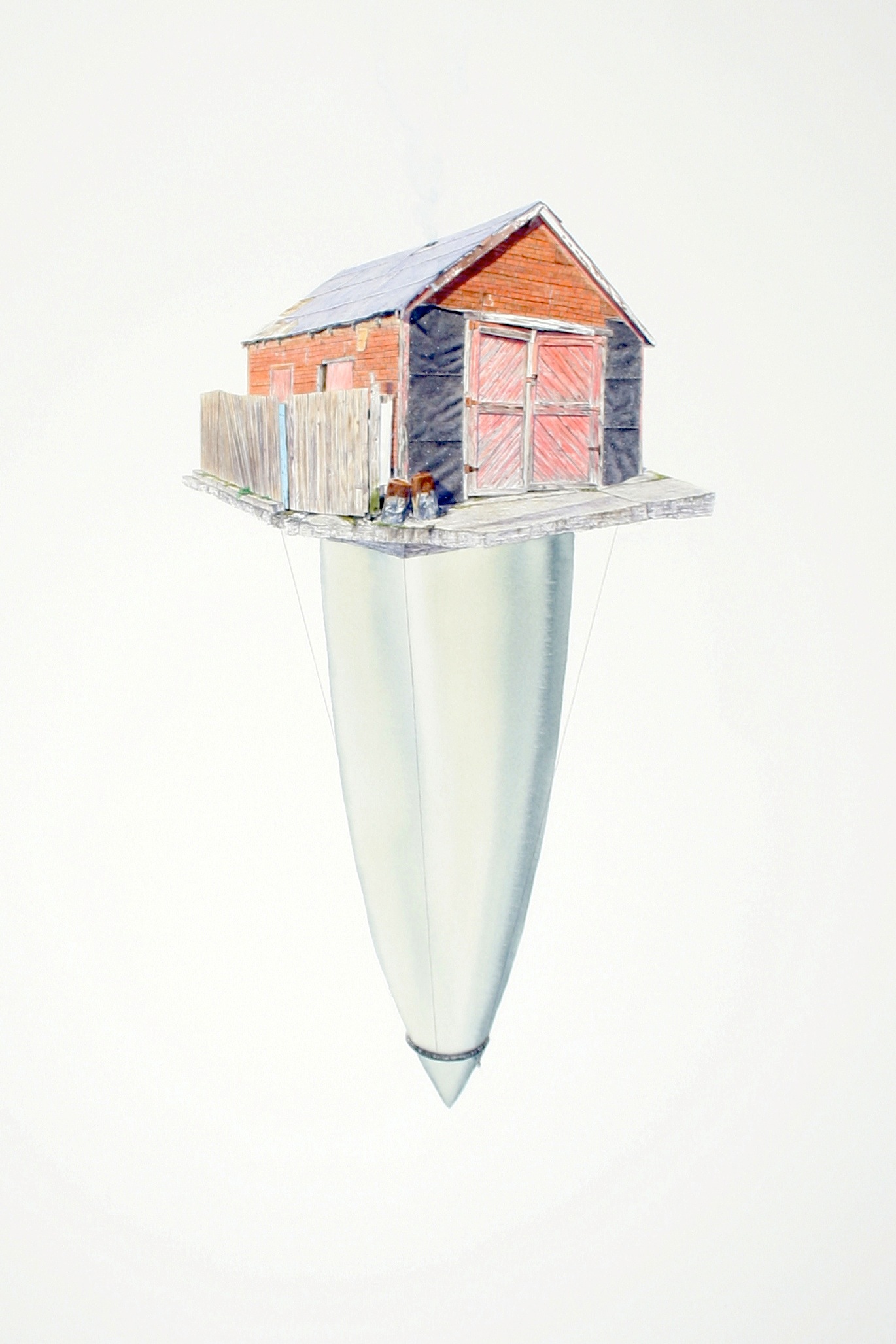Toronto-based artist Tristram Lansdowne (featured) opens his New York – and United States – solo debut “Refuge” this coming Saturday, February 13th, at Joshua Liner Gallery in the heart of Chelsea. The exhibition follows his recent solo show with LE Gallery in Toronto last year (see our coverage here) and we’re definitely enjoying Tristram’s vision of the defaced and derelict, along with the surprises that may lie within or beneath the surface.
AM caught up with Tristram and put some questions to him ahead of the opening. Read our interview and browse some preview images after the jump.
Arrested Motion (AM): First off Tristram, many thanks for taking the time to speak with us ahead of your New York solo debut. Can we start by asking you to give us and our readers a little background information about you and your journey so far?
Tristram Lansdowne (TL): Sure. I’m from the west coast of Canada, finished my undergrad in art three years ago and now live in Toronto. My work is landscape based, so I spend a lot of time roaming the streets and countryside taking photos which I use as reference material for my paintings.
AM: The title of the exhibition is ‘Refuge’. I can see how this applies to the content of some of your paintings – perhaps from the depiction of the womb-like subterranean safe havens underneath the decaying buildings at street level, but can you tell us a little about the title, and also what you are trying to communicate with this body of work?
TL: Well, I’m drawn to the areas of cities that are on the fringe, in-between zones, say between an industrial park and a housing development. They can be very haunting, and in a way the paintings come from a childlike desire to explore hidden worlds. Often people do inhabit these areas – homeless people, drifters, graffiti artists, and the layers of usage that build up are incredible. So, I see a connection between this kind of landscape and a basic need for shelter. I combine this with a more theoretical exploration of the landscape, i.e. what makes a place a place? Is it the house on top or the dirt underneath? how does the function of a place change over years, or moment to moment? So these buildings and things that I find end up becoming imaginary artifacts, based on reality but with additional elements.
AM: You recently shared with us some details of how one of the paintings ‘Billow’ came together (see that here), and we enjoyed understanding how you actively go out to find subject matter. Is this process fairly typical for your work and how might it change for the underground elements, such as that shown in ‘Brush Park’, which obviously cannot be found and photographed? Where do these underground spaces come to you from?
TL: ‘Billow’ is pretty typical of my process, in that I find almost all my subject matter by walking around and taking photos, and I like to combine different elements in improbable ways. I started painting building foundations because I was so awestruck by the size of skyscrapers, and wondered how much they must weigh. From there, I really got into all the different connotations of the word ‘underground’ and found that the diagrammatic way of showing a building or landscape was a good way to counter my very literal way of painting.
AM: One of my favourite pieces in this show is ‘The Bilder’ – I love the combination of the barn and the boat hull. What connection do these two elements share that prompted you to combine them?
TL: The idea first came from thinking about underground rivers and having a garage that is secretly a boathouse. Architecturally though, I believe elements of barn architecture are based on ship design, as are the large roofs of churches. So, I thought it would be interesting to have a ship being built inside a barn, and have it unclear as to whether the barn was being turned into a boat, or the boat was being attached to the bottom of the barn, or what. Also with a big imaginary boat there is unavoidably a reference to an ark, so there are overlapping connections between these utilitarian structures and spiritual ones. I was hoping that this combination would convey a kind of subterranean end-of-the-world anxiety.
AM: Where does your attraction to architecture and structures – and in particular the dereliction you portray come from?
TL: I’m not sure. Abandoned buildings have a lot of mystery to them. Growing up in Victoria, I spent a lot of time in the wilderness, hiking and camping, and now that I’m in Toronto, I think I try to connect with the urban environment in similar ways, hiking and cycling around, exploring. Over time, I’ve become more and more interested in architecture, urban planning, and the mythologies of cities.
AM: Your recent paintings are solely in watercolour – I understand that this is a difficult medium to conquer. What is it that attracts you to watercolour and steers you away from using acrylic or oils?
TL: Watercolour is the medium I’m most comfortable with, technically. t’s what I first learned to paint with, and I think it makes sense to paint the subjects that I do in watercolour. It’s a medium that is connected to scientific illustration and natural history illustration, which my work is informed by. I would like to spend more time painting in oil, but I wouldn’t want to paint the same kind of pictures as these in oils. I don’t think it would make as much sense.
AM: The work seems to carry a lot of detail – I think you must be a perfectionist to strive to inject the level of detail you use! Do you drive yourself crazy chasing the perfect composition or does your approach come loose and easy?
TL: I begin with a lot of loose sketching and work my way into a fairly tight plan before I start painting. Sometimes, a tiny sketch that took five seconds can be enough to get an idea going, but trying to combine disparate elements convincingly can be a headache.
AM: Graffiti features heavily in your work – where does your interest in graf come from? Have you ever taken to the streets with a spray can?
TL: I spent a few years writing and I have a great appreciation for graffiti. Actually, doing graffiti was one of the things that led me to explore the back alleys and vacant lots that now inform my work.
AM: One of the pieces we saw in your last solo show at LE Gallery in Toronto (covered here) featured a painting that had to be viewed through a periscope to be seen. Pretty cool! Do you have any plans to continue with sculptural / installation work in the future?
TL: I really enjoyed making the periscope, and I’d like to continue in that vein. The combination of found object and hand-made material was appealing, so I’ll have to find some more objects that I can work with.
AM: I understand you moved from one end of Canada – Victoria B.C. to Toronto recently. What drew you to Toronto, and what inspires you to place yourself there?
TL: I spent three years at art school in Toronto, so I have a lot of friends here. When I graduated I moved back to Victoria and tried to paint there because I love Victoria, but I found that the community of artists that I had at school was very important to me, so I ended up moving back. I share a studio with friends from school and we give each other lots of feedback. It’s great to have people nearby to critique your work and share ideas with.
AM: Are you able to support yourself as a full time artist at this point in time? Looking to your recent past can you fondly recall any stories of being a struggling artist whilst working through your education and early days starting out on your own?
TL: I’m not sure! I’m going to try, and maybe this year I’ll be able to. I’ve had part time jobs over the last few years, teaching ESL, working as an assistant for another painter. I have to admit I’ve had it pretty easy so far. My family has been very supportive and I’ve been lucky to get jobs when I’ve needed them.
AM: Can you tell us how your studio routine works – are you a tranquility guy or loud music guy when you work?
TL: I find I work best in the morning, so I try to get to the studio early, about eight-thirty or nine. That way I have a couple hours to myself to paint and work on ideas before anyone else gets in. I’m definitely a tranquility guy, although we always have music on in the studio.
AM: Where do your creative influences lie? Are there any artists that you particularly enjoy in the new contemporary scene?
TL: I’m kind of all over the place. I think I’ve been very influenced by the work of my father, and the natural history painting aesthetic. I’ve drawn a lot from from Piranesi, from Winslow Homer’s watercolours, from architectural manifestos, and in certain ways from Gordon Matta-Clark. I probably look at artists from the past more than contemporary ones, but I really like the work of David Schnell, Nicholas Di Genova, Jules De Balincourt, Daniel Arsham, Walton Ford….
AM: Where did your interest in art initially come from? Did you have any direct artistic inspiration with your family?
TL: Yeah. My dad was a painter named Fenwick Lansdowne. He painted portraits of birds, in a very traditional style based on artists like Audubon. He was very supportive and growing up I always had someone to talk to about art and look at my pictures. He had an incredible sense of colour and composition, and he helped me a lot. He even let me use all his materials.
AM: There’s a ton of great art to see in New York. Do you have any plans to check out any other galleries or art exhibitions whilst you are in NYC?
TL: Absolutely, although its pretty overwhelming – I don’t know where to start. I’m really sorry I’m going to miss the Velasquez show at the Met, but I’m looking forward to seeing Gabriel Orozco at MoMA. Also, there will be a Nicholas Di Genova show at Fredericks & Freiser which I think will be really good.
AM: Finally, can you share any plans you have for the remainder of 2010 with us?
TL: Yeah, I’m going to be in a group show at the Museum of Contemporary Canadian Art in the summer called Empire of Dreams, and I have a show in December at LE Gallery.
AM: Many thanks for taking the time to talk to us Tristram – We wish you the very best of luck with the show – hope you enjoy the opening!
TL: Thank you very much!









